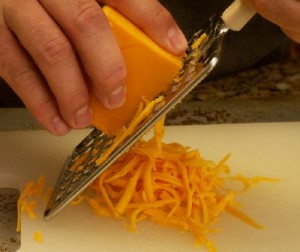How to Grate Cheese

Cheese is derived from the protein and fats of milk, a product of something called coagulation. This process uses acidity to cause solids to separate and then be pressed into the final form. Cheese is widely eaten world round, and many of the popular dishes it contributes to call for the cheese to be grated.
The grating of cheese is the act of reducing it to small shreds using a kitchen tool known as a grater. This device can also be used for vegetables, fruits and other similar foodstuffs.
Instructions
-
1
Select Cheese
Before we are able to grate cheese, it is important to select the right cheese. This depends on the dish you are using it for and what the recipe calls for.
For best results, grated cheese should either be a hard cheese or a medium one. Softer cheeses are usually spread rather than being grated. -
2
Plate Up!
The end product of your grating should end up on a plate. Given the amount you will be grating, select a large plate that ideally has curved ends. This aids in keeping the cheese on the plate as your grate. -
3
Amount of Cheese
Before grating, it is also important to determine the amount of cheese you will need. Once you have done so (either by eye or based on a recipe), use a sharp knife to cut the required amount of cheese and place the piece on your plate. -
4
Grate Time
Always use a clean grater when grating anything. Prior to using it, ensure that it is free of old food remnants. If it is not, be sure to clean it and dry it using soap water and a sponge or by placing it in a dishwasher.
You will be grating the cheese over the plate. To do this, angle the grater 45 degrees with the top leaning towards you. Hold it in place with your non-dominant hand. The base of the grater should sit in the centre of the plate. -
5
Down and Back
Once your grater is in place, it's time to shred some cheese. It is always suggested that the longer side of your cheese piece be grated first. This usually makes it easier to hold the cheese as well as grate it faster.
To grate cheese, hold it firmly in your hand and steadily lead it down the grater. Be sure to keep your fingers away from the grater, using them only to hold the cheese down.
Once you have moved the cheese from top to bottom, take a look to determine that the cheese has grated properly. Once you have done so, grate down and move the cheese back up to the top, repeating until the cheese is completely grated. -
6
Rotate
As you grate the cheese, it will change shape and may become more challenging to hold. To prevent this, rotate the position of the cheese in your hands, making sure to be able to keep your fingers away from the grater while still consistently grating cheese.







